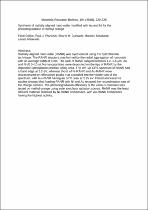 ResearchSpace
ResearchSpace
Synthesis of radially aligned nano-rutile modified with Au and Ni for the photodegradation of methyl orange
JavaScript is disabled for your browser. Some features of this site may not work without it.
- ResearchSpace
- →
- Research Publications/Outputs
- →
- Journal Articles
- →
- View Item
| dc.contributor.author |
Dziike, F

|
|
| dc.contributor.author |
Franklyn, PJ

|
|
| dc.contributor.author |
Durbach, SH

|
|
| dc.contributor.author |
Maubane, M

|
|
| dc.contributor.author |
Hlekelele, Lerato

|
|
| dc.date.accessioned | 2019-11-28T08:20:18Z | |
| dc.date.available | 2019-11-28T08:20:18Z | |
| dc.date.issued | 2018-08 | |
| dc.identifier.citation | Dziike, F. (et.al.) 2018. Synthesis of radially aligned nano-rutile modified with Au and Ni for the photodegradation of methyl orange. Materials Research Bulletin, v104, pp 220-226. | en_US |
| dc.identifier.issn | 0025-5408 | |
| dc.identifier.issn | 1873-4227 | |
| dc.identifier.uri | https://www.sciencedirect.com/science/article/pii/S0025540817334396 | |
| dc.identifier.uri | https://doi.org/10.1016/j.materresbull.2018.04.016 | |
| dc.identifier.uri | http://hdl.handle.net/10204/11242 | |
| dc.description | Copyright: 2018 Elsevier. Due to copyright restrictions, the attached PDF file only contains the abstract of the full text item. For access to the full text item, kindly consult the publisher's website. | en_US |
| dc.description.abstract | Radially aligned nano-rutile (RANR) was synthesized using the hydrothermal technique. The RANR structure was formed by the radial aggregation of nanorods with an average width of 9 nm. The radii of RANR ranged between 1.2–1.6 µm. Au and Ni (0.5–10 wt.%) nanoparticles were deposited on the tips of RANR by the deposition-precipitation method using urea. The UV–vis DRS spectrum of RANR had a band edge at 3.2 eV, whereas those of Ni-RANR and Au-RANR were characterized by reflectance peaks that extended into the visible part of the spectrum, with Au-RANR having an SPR peak at 2.25 eV. Photoluminescence studies showed that loading RANR with Ni and Au reduced the recombination rate of the charge carriers. The photodegradation efficiency of the various materials was tested on methyl orange using solar simulator radiation source. RANR was the least efficient material, followed by Ni-RANR composites, with Au-RANR composites having the highest activity. | en_US |
| dc.language.iso | en | en_US |
| dc.publisher | Elsevier | en_US |
| dc.relation.ispartofseries | Worklist;21249 | |
| dc.subject | Photodegradation | en_US |
| dc.subject | Radially aligned nano-rutile | en_US |
| dc.subject | Metal loading | en_US |
| dc.subject | Photocatalysis | en_US |
| dc.subject | Methyl orange | en_US |
| dc.title | Synthesis of radially aligned nano-rutile modified with Au and Ni for the photodegradation of methyl orange | en_US |
| dc.type | Article | en_US |
| dc.identifier.apacitation | Dziike, F., Franklyn, P., Durbach, S., Maubane, M., & Hlekelele, L. (2018). Synthesis of radially aligned nano-rutile modified with Au and Ni for the photodegradation of methyl orange. http://hdl.handle.net/10204/11242 | en_ZA |
| dc.identifier.chicagocitation | Dziike, F, PJ Franklyn, SH Durbach, M Maubane, and Lerato Hlekelele "Synthesis of radially aligned nano-rutile modified with Au and Ni for the photodegradation of methyl orange." (2018) http://hdl.handle.net/10204/11242 | en_ZA |
| dc.identifier.vancouvercitation | Dziike F, Franklyn P, Durbach S, Maubane M, Hlekelele L. Synthesis of radially aligned nano-rutile modified with Au and Ni for the photodegradation of methyl orange. 2018; http://hdl.handle.net/10204/11242. | en_ZA |
| dc.identifier.ris | TY - Article AU - Dziike, F AU - Franklyn, PJ AU - Durbach, SH AU - Maubane, M AU - Hlekelele, Lerato AB - Radially aligned nano-rutile (RANR) was synthesized using the hydrothermal technique. The RANR structure was formed by the radial aggregation of nanorods with an average width of 9 nm. The radii of RANR ranged between 1.2–1.6 µm. Au and Ni (0.5–10 wt.%) nanoparticles were deposited on the tips of RANR by the deposition-precipitation method using urea. The UV–vis DRS spectrum of RANR had a band edge at 3.2 eV, whereas those of Ni-RANR and Au-RANR were characterized by reflectance peaks that extended into the visible part of the spectrum, with Au-RANR having an SPR peak at 2.25 eV. Photoluminescence studies showed that loading RANR with Ni and Au reduced the recombination rate of the charge carriers. The photodegradation efficiency of the various materials was tested on methyl orange using solar simulator radiation source. RANR was the least efficient material, followed by Ni-RANR composites, with Au-RANR composites having the highest activity. DA - 2018-08 DB - ResearchSpace DP - CSIR KW - Photodegradation KW - Radially aligned nano-rutile KW - Metal loading KW - Photocatalysis KW - Methyl orange LK - https://researchspace.csir.co.za PY - 2018 SM - 0025-5408 SM - 1873-4227 T1 - Synthesis of radially aligned nano-rutile modified with Au and Ni for the photodegradation of methyl orange TI - Synthesis of radially aligned nano-rutile modified with Au and Ni for the photodegradation of methyl orange UR - http://hdl.handle.net/10204/11242 ER - | en_ZA |





